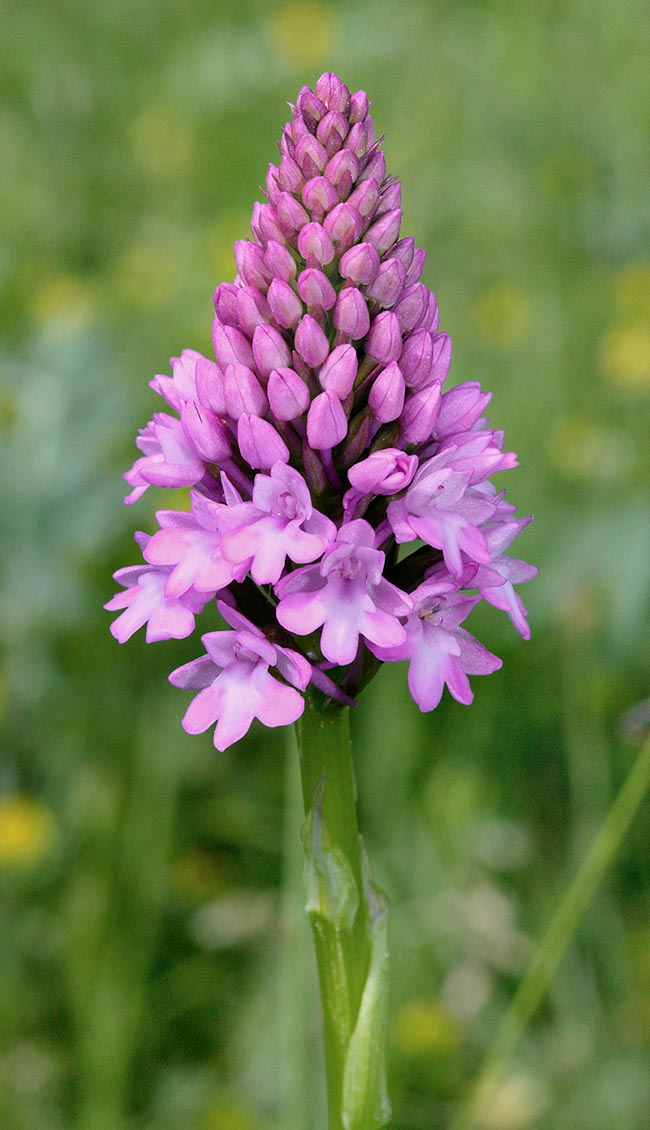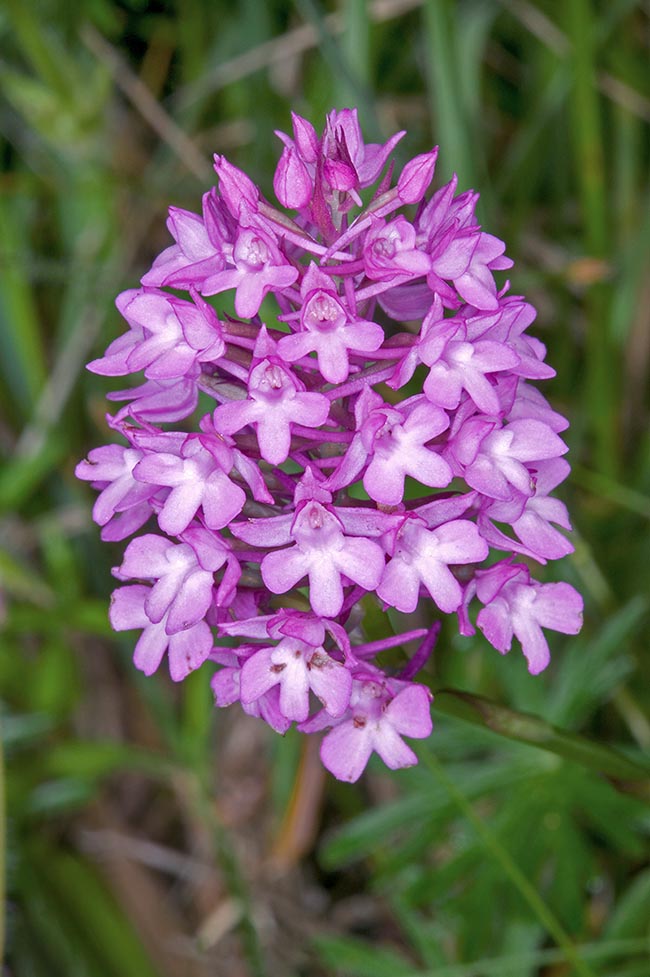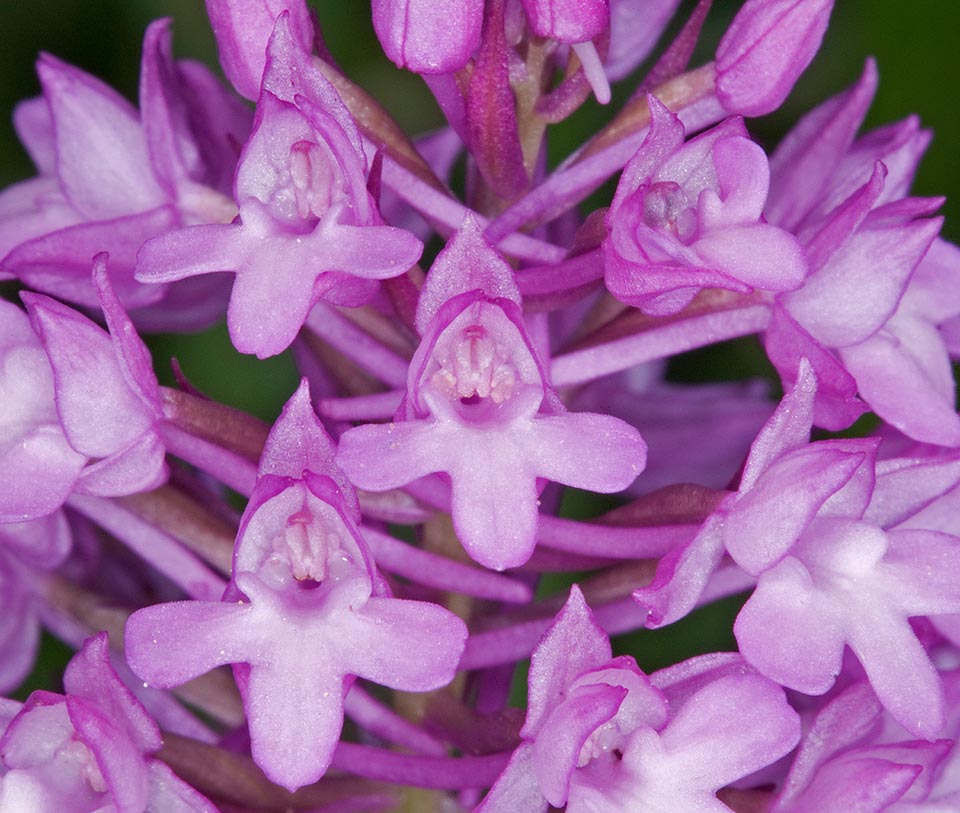Family : Orchidaceae

Text © Dr. Salvatore Cambria

English translation by Mario Beltramini

Anacamptis pyramidalis has a vast distribution range in Europe, North Africa and Middle East © Giuseppe Mazza
Anacamptis pyramidalis is a species belonging to the family of the Orchidaceae, originally described by Linnaeus as Orchis pyramidalis in his famous opus Species Plantarum of 1753 and later on transferred to the new genus Anacamptis by the French botanist Louis Claude Marie Richard in 1817 in his “De Orchideis Europaeis Annotationes”.
The name of the genus Anacamptis comes from the Greek verb “anacámptein” to fold or to bend, referring to the long spur of the flower or to the shape of the tepals curved upwards.
The specific epithet pyramidalis comes from the Latin pyramidal, due to the characteristic form of the inflorescence of this orchid.
The species has a vast distribution area going from the central-northern regions of Europe to the Mediterranean area, including some regions of North Africa and of Middle East, moving towards the east up to Iran.
In Italy it is present in all regions.
From the ecological point of view, it is found in open and sunny areas like clearings, meadows, escarpments, roadsides, uncultivated fields, pastures and garrigues, preferring the calcareous soils.
Usually, it is found from the sea level up to 800 m, but exceptionally even up to 1400 m of altitude.
It is a perennial herbaceous species, 20-30(60) cm tall, characterized by roots having two ovoid-elliptical tubers and by some rootlets.
The stem is rather slender, of pale green colour, glabrous and glossy, at times corrugated and angular in the upper part.
The basal leaves are linear-lanceolate, acute, pale green colour, up to 25 cm long, whilst the cauline ones become progressively shorter and adherent to the stem approaching the apex until transforming in violaceous and acuminate bracts.
Usually, the leaves tend to dry up at the time of flowering.
The inflorescence is very showy and is rather dense and of roughly pyramidal shape at the beginning and then, progressively, more cylindrical.
The about 10 mm long flowers appear between March and June, depending on the climate conditions. Their colour includes all shades of pink, ranging from light pink to cobalt purple, whilst is white only rarely. Each flower has a linear bract, lanceolate, with a purplish spot above, with a length like that of the ovary, thin and twisted to S.
The outermost lateral tepals are ovate-lanceolate and stretched backwards, whilst the central one and the inner contiguous lateral ones are merged to form a sort of a casque over the gynostemium. The labellum is trilobed with lobes having more or less the same size, but quite variable in shape and size. At the base of the median labellum are present two narrow longitudinal lamellae, narrow and slightly spread forward and stretched downwards.

The inflorescence, initially pyramidal, gets progressively cylindrical © Giuseppe Mazza
The spur is very thin, filiform and supple, up to 15 mm long, rich in nectar and facing backwards and downwards.
The fruit is a capsule with many seeds inside. It reproduces by entomophilous pollination done by lepidoptera.
In fact the pollination occurs thanks to some species of butterflies, who, attracted by the effluvia of the nectar, project the proboscis towards the entrance of the spur in order to reach the nectar.
The two basal lamellae of the labellum allow the butterflies to lay down their body between them and the Lepidoptera in such way may unroll the proboscis that, once inside the spur, is obliged to hit the pollen masses located along the way for reaching the nectar. In this way gets free the adhesive disk with the pollens that go to stick to the proboscis.
When the butterfly visits another flower, some pollen grain contained in its proboscis will be easily released during the impact with the stigma, starting the fecundation.
Within this species, with a great morphological variability, have been identified several taxa of intraspecific rank, as subspecies and varieties.
For instance, some Authors have identified in central-southern Italy, the subsp. serotina Presser that distinguishes from the typical form because of the later flowers (flowering in June-July), smaller, of pale pink colour and with sparser and roughly spherical inflorescence. However, such an entity is not recognized in many florae and checklists.
Within the known varieties we can recall: Anacamptis pyramidalis var. nivea P. Delforge, with white flowers, fairly common in southern Italy; Anacamptis pyramidalis var. tanayensis Chevenard, with smaller flowers than the type and of purplish colour, diffused in the Swiss and French Alps; Anacamptis pyramidalis var. urvilleana, with small, white-pinkish flowers and oblong inflorescence, early flowering (February-April); present in the islands of the Maltese archipelago. The latter is at times treated as subspecies or even as a species itself (Anacamptis urvilleana Sommier & Caruana Gatto).
It is known the presence of hybrids with other species of Anacamptis, among which can be mentioned: Anacamptis × duquesnei (A. palustris × A. pyramidalis); Anacamptis × klingei (A. laxiflora × A. pyramidalis); Anacamptis × laniccae (A. morio × A. pyramidalis); Anacamptis × simarrensis (A. coriophora fragrans × A. pyramidalis); Anacamptis × van-lookenii (A. papilionacea × A. pyramidalis).

Pollination is entrusted to some species of butterflies attracted by the scent of the nectar. Numerous hybrids, even with other genera of Orchidaceae © Giuseppe Mazza
Anacamptis pyramidalis can also hybridize with other species belonging to other genera of Orchidaceae, like, for instance, × Serapicamptis forbesii Godfery (A. pyramidalis × S. lingua).
The common Italian name is Orchidea Piramidale, but in the different regions of the country the species is known with other dialectal appellations. For instance, in the Veneto region it’s called Aio de can, Cipolla cipressina in Tuscany, Cocolutis di prad in Friuli, Pizzungurdu in Sicily, etc.. In English it is known as Pyramidal Orchid, whilst in France it is known as Orchis pyramidal.
Synonyms: Orchis pyramidalis L. (1753), Aceras pyramidale (L.) Rchb.f. (1850), Anacamptis brachystachys (d’Urv.) Nyman (1890), Anacamptis pyramidalis subsp. durandii (Bréb.) K.Richt. (1890), Anacamptis durandii Bréb (1835), Anacamptis pyramidalis subsp. algarbiensis Gand. (1910), Anacamptis pyramidalis subsp. condensata (Desf.) H.Lindb. (1932), Orchis appendiculata Stokes (1812), Orchis brachystachys d’Urv. (1822), Orchis condensata Desf. (1799), Orchis cylindrica K.Koch (1846).
